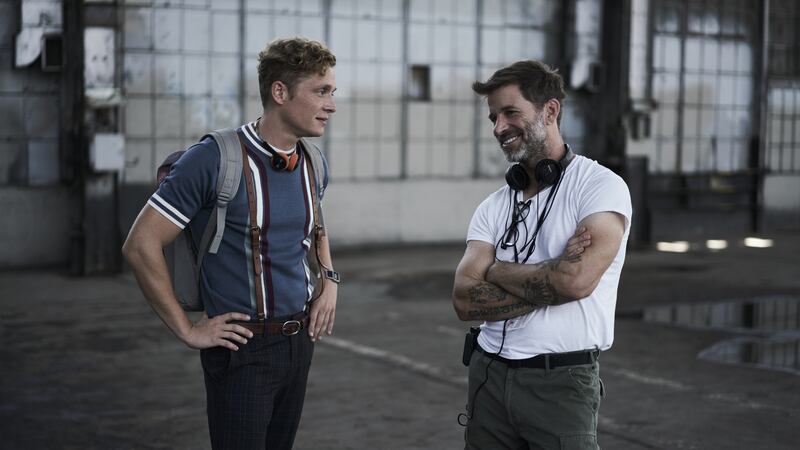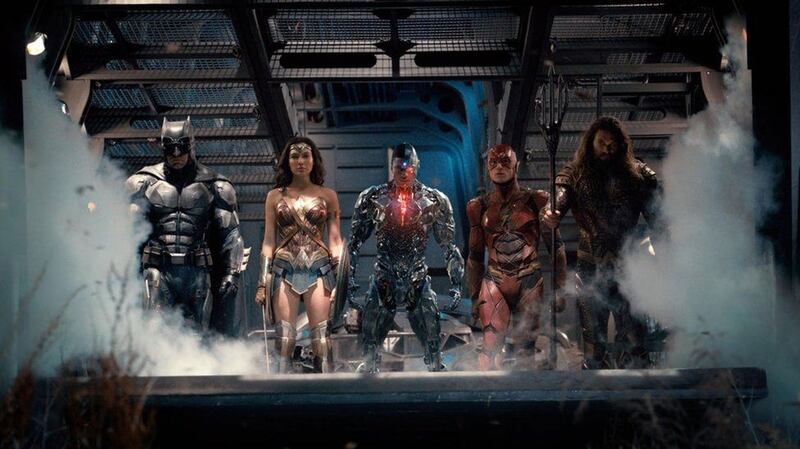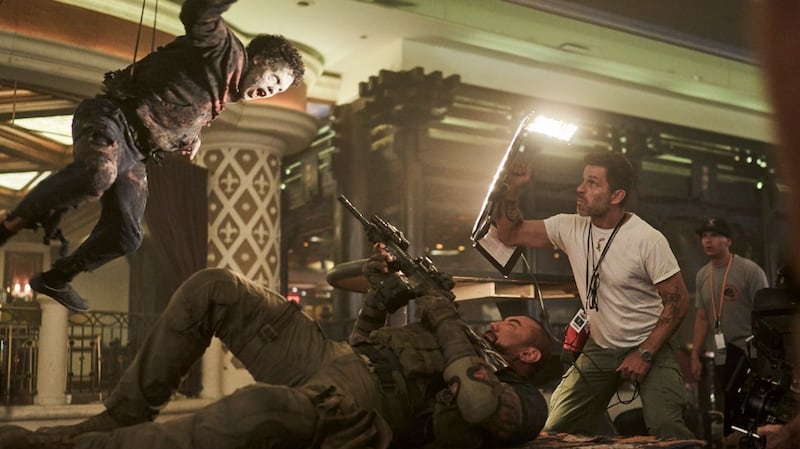Sarah Polley leads a team that may or may not survive hordes of shambling zombies in the 2004 remake of George Romero's Dawn of the Dead. Gerard Butler leads 300 Spartans into battle against the Persian "God-King" Xerxes and an invading army of more than 300,000 soldiers. A team of scantily clad young women improbably train as warriors in 2011's Sucker Punch. Batman and Wonder Woman lead a team comprising The Flash, Aquaman, Cyborg and the late Superman to take on the nefarious Steppenwolf.
Some 17 years after Zack Snyder’s feature debut, it’s fair to say that there’s a pattern emerging.
“I don’t know why,” laughs Snyder. “I always say I want to do a movie about one person. I want to do a remake of Castaway or something. I’m writing a movie right now. And my wife is like: what is it with you? Stop with the fucking teams! You’re going to do another team thing? You’re right. I have to have a team. In my mind, I have to get the family together in order to go forward.”
In this spirit, Army of the Dead, Snyder's new heist movie for Netflix, sees Dave Bautista lead a team of mismatched adventurers, including his estranged daughter, a German safecracker, a Mexican sharpshooter, former mercenaries and a wise-cracking helicopter pilot (Tig Notaro) into a zombie-infested Las Vegas. Their mission: steal more than $200 million from a casino vault before the US military destroys the city with a tactical nuclear strike.

“I’ve always been a fan of the Romero films, for their social commentary and their groundbreaking use of horror and genre as a way of holding the mirror up to us, to our own society and us as a species,” says the director. “Zombie movies are at their best when they are showing us something about ourselves, because, in a zombie film, the monster is us, only without our humanity. This film shows how we treat each other – what we’re capable of as a species, what we do in response as a people, whether it be to put people in refugee camps or build walls.
“People are always like, ‘Oh, you know, do these movies have to be so political? So heavy in that way?’ Well, yes. Because the best zombie movies are the ones that talk about who we are. And that does lead to these esoteric and fun questions. What are they trying to achieve? Maybe they represent an opportunity to usurp the human race.”
Unlike its Romero-created antecedents, Snyder’s ninth film as a director uses a folk version of Viva Las Vegas, dreamy electric noodling from Junkie XL and – given pride of place – Zombie by The Cranberries.
“I was obsessed with that song when it came out,” he says. “I’m obsessed with Ireland anyway. I shot there a few times, mostly TV commercials. I’ve always hoped that I can convince my wife to buy a house in Ireland at some point and just, you know, spend our summers there. Maybe not the winters. Summers for sure.
“Anyway, I love The Cranberries. I’m a huge fan. And I just felt like the song belonged. I understand that it’s a political song. I understand that it really exists outside of this genre, completely outside. But for me, the irony of it being in this movie felt like a thing that I just couldn’t resist. I had to do it.”
Glitzy unveiling
Army of the Dead, despite its glitzy unveiling at Netflix, was in Snyder's mind – and arriving after the $300 million-plus budget for Justice League – a small film in which he served as his own cinematographer and shot a small group of actors "doing their thing". It was the polar opposite to his major excavation on Justice League, a project that briefly overlapped with Army of the Dead.
“Thank God we had just about finished the cut of Army when we got the green light to go ahead and do Justice League,” says Snyder. “So, um, now we’re going to go and cut this giant movie. It was daunting. It was only because we had Army under control that we were able to do it. I think if we had been in the middle of cutting the Army, I would have said: I don’t even know how to do this. Because, I mean, it’s hard enough making a movie without this additional insanity of making two movies.”
Justice League, released in 2017 to mediocre notices and landing almost $100 million shy of its estimated $750 million break-even point, is a movie that won’t go away. The project marked the end of Snyder’s relationship with Warner Brothers, the studio that had previously entrusted him with the entire DC extended universe. That should have been that until Synder’s rabid fan base intervened.
More reasonable voices among the #ReleaseTheSnyderCut movement suggested that Justice League's flaws could not be attributed to Snyder, who left midway through production following the death of his daughter, one of his eight children. His departure made way for Avengers director Joss Whedon to finish the film. Less reasonable voices have characterised Whedon as an agent provocateur, out to ruin the Extended Universe's flagship film on behalf of Disney and the Marvelverse.

In the current age of craven fan service, the hashtag was powerful enough to motivate Warner Brothers to bring back Snyder, hand him $70 million for reshoots, and unveil a four-hour director’s cut earlier this year. (The fans continue to grumble that Snyder won’t get to return for future instalments, having introduced Deathstroke and Darkseid in the director’s cut; they have, additionally, railed against the inclusion of Amber Heard and the retention of Aquaman’s air bubbles.)
The director has described the studio as being “aggressively anti-Snyder” and remains astonished that it brought him back. “I was 100 per cent surprised. I didn’t know it was coming. I really, to this day, I’m shocked that we did the movie because it really doesn’t make any sense. I’m glad we did. I saw that in the UK and Ireland it’s, like, still No 1. And No 3 on the download chart.”
Snyder (55) is amiable and always quick to laugh. It’s difficult to reconcile this with his reputation for being – as his wife and producing partner, Deborah, has it – a divisive talent.
Writing in 2017, IndieWire's David Ehrlich noted that Snyder's "name alone is enough to launch a thousand angry tweets, and the most passionate writing about his work is exclusively found in the comment sections of websites like this one. Snyder's critics really seem to hate him, and Snyder's fans really seem to hate his critics ... Is Snyder a master or a hack? A misunderstood myth-maker, or a meathead with a movie camera?"
Greek mythology on steroids
He certainly knows his movies and his Joseph Campbell. Snyder was born in Green Bay, Wisconsin, and raised as a Christian Scientist in Connecticut. He became a lifelong fan of comic books and horror films at an early age.
“I haven’t changed. I think my particular sensibilities have a market value. And that’s cool. But it could very well be the other way around. For instance, if instead of superhero movies, we had gotten drawing-room dramas, you might not know who I am. That’s just the way things have gone. And that has worked out for me, knock on wood. I think that the ideas in comics and superhero movies are pretty universal. They are archetypal. It’s pretty much Greek mythology on steroids.”
Following in his mother’s footsteps – she was a painter and photography teacher – the teenage Snyder studied at Heatherley School of Fine Art in England for a year before switching to a BFA in Pasadena. He continues to live there with Deborah (née Johnson). The couple are, as the New York Times noted in a 2011 portrait, a package deal.

“It’s weird,’’ says Snyder. “The movies are definitely at the dinner table. The movies are there when we go for a drive in the car. I’m like, you know what, can you read me this? And Debbie will read it to me and make notes. Everything’s a movie. It’s a good and bad thing. You can imagine.
“But you know, at least we both enjoy it. And we’re both in it together. So it’s fun that way. I’ll start a sentence in the middle of an idea. And she’ll be like: what are we talking about? Don’t do that. And I’ll say, okay, sorry; remember what we were talking about? Okay, now go. I think that we keep each other sane. And we have each other’s backs. This is a slightly cut-throat business so you have to keep your friends close.”
Snyder tends toward the grandiose as a film-maker, with projects such as pitching Superman against Batman. He has, however, toyed with the idea of adapting Ayn Rand's The Fountainhead and a biopic of George Washington. There is also The Last Photographer, a film about a war correspondent who is the lone survivor of an attack in Afghanistan, a project that has variously had Sean Penn and Christian Bale attached in its decade-long development.
“A solitary guy surviving in the wild, “ says Snyder. “He’s on a mountain and gets cut off from humanity and he’s got to find his way.”
He laughs: “But then he finds his team. And they end up at the Alamo. And they’re like: Oh my God, are you serious?”
Army of the Dead is now on Netflix













